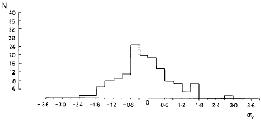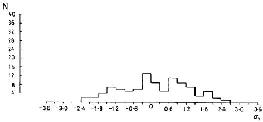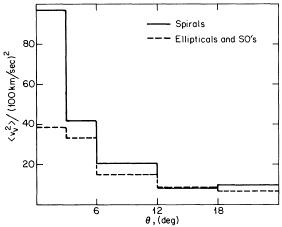


3.3. Kinematical segregation
The issue of kinematical segregation also dates back to the 30's. Smith [425] pointed out that there was no evidence for bright and faint galaxies in the Virgo cluster to have different velocity distributions, and so did Zwicky [513] for galaxies in the Coma cluster. The first evidence for kinematical segregation of cluster galaxies came from Holmberg [225] who, as early as in 1940, noticed that Virgo spirals had a larger velocity dispersion than Virgo ellipticals, thus anticipating Tammann [446]'s result.
Chandrasekhar
[103]'s
paper on dynamical friction showed how
the more massive galaxies in a cluster could decelerate
with respect to the less massive galaxies. However, a huge
observational effort was needed before a clear evidence for
kinematical segregation was established. In 1960, only 50 redshifts
were known for galaxies in the Coma cluster, each obtained through
 2 hours exposures
[297],
leading Mayall to complain
that the ``current rate of less than 10 velocities per year is
impracticably slow''.
2 hours exposures
[297],
leading Mayall to complain
that the ``current rate of less than 10 velocities per year is
impracticably slow''.
In 1964, Zwicky & Humason [529] had obtained 42 galaxy redshfits in the cluster Abell 194. They claimed that the 21 brightest galaxies had a higher velocity dispersion than the 21 faintest. Reanalyzing their data with a biweight estimator [56] proves their result was correct. In fact, there is a difference of 200 km/s between the velocity dispersions of the bright and faint samples, and this is significant at the ~ 95 % level. The conclusions of Zwicky & Humason were confirmed 13 years later by Chincarini & Rood [108], on a slightly larger sample of 57 redshifts for cluster members. Meanwhile, in 1972 Rood et al. [385] had shown the velocity dispersion of bright galaxies in the Coma cluster core to be as low as 231 km/s.

|

|
Figure 11. The combined velocity distribution of ellipticals and S0s (top panel) and spirals (bottom panel) in five clusters. From Moss & Dickens (1977). |
In the same year, Tammann [446] put Holmberg's early result on solid bases, by analyzing a sample of 122 Virgo cluster members with available velocities. Tammann showed that the velocity dispersion of Virgo spirals was 40 % higher than that of ellipticals and S0s. Tammann's result was extended by Moss & Dickens [313] to clusters in general. Moss & Dickens showed that the velocity distribution of ellipticals and S0s is broader than that of spirals not only in Virgo, but also in Abell 194, 262, and 1367 - see Fig. 11. Kent & Gunn [252] later found the same effect in Coma.
Struble [437] considered 13 galaxy clusters, each with at least 30 galaxy redshifts, up to a maximum of 325 in Coma. Using the variance-ratio test he showed that there was no evidence for kinematical segregation with luminosity, except in Coma. Since Abell 194 was among the clusters he considered, his result was at odds with those of Zwicky & Humason [529] and Chincarini & Rood [108]. Struble noticed that several clusters have a lower velocity dispersion in their cores, and interpreted it as a product of cannibalism and/or dynamical friction, a scenario that still holds [22].
Thanks to the huge observational effort of the 70's, in 1980 there were more than 800 Virgo cluster galaxies with available redshifts. Using this sample, Hoffman et al. [222] constructed the velocity dispersion profile of the Virgo cluster, for spirals and early-type galaxies separately. Not only the velocity dispersion of spirals was confirmed to be higher than that of ellipticals and S0s, but also the shapes of the velocity dispersion profiles were different. By looking at Figure 9 in Hoffman et al.'s paper - here reproduced in Fig. 12 -, we can notice that the velocity dispersion profile of spirals is significantly steeper than that of early-type galaxies. It almost took 20 years to extend the validity of such a result to clusters in general (Adami et al. [22]).

|
Figure 12. The velocity dispersion profiles for ellipticals and S0s (dashed line) and spirals (solid line) in the Virgo cluster. From Hoffman et al. (1980). |